Aerospace Micro-Lesson #82
In This Section
The Douglas DC-3
The DC-3, a passenger airplane designed and built by the Douglas Aircraft Corporation in the 1930s, served the United States and her allies during the Second World War as the C-47 cargo plane. Some of its accomplishments are the stuff of legend. This lesson recounts a few of them.
Next Generation Science Standards (NGSS):
- Disciplinary: Engineering, Technology, and Applications of Science
- Crosscutting Concept: Structure and Function
- Science & Engineering Practice: Constructing Explanations and Designing Solutions
GRADES K–2
NGSS: Engineering Design: Ask questions, make observations, and gather information about a situation people want to change to define a simple problem that can be solved through the development of a new or improved object or tool.
The earliest planes were built from wood and light fabrics to keep the weight down and make it easier for the engine(s) to power the craft. As the commercial possibilities of aircraft were explored, stronger planes able to handle extreme weather and longer flights were needed. Besides delivering mail or cargo, passenger flights began to take place, but people were nervous about the wooden construction of earlier planes and companies began working on metal aircraft with more powerful engines.
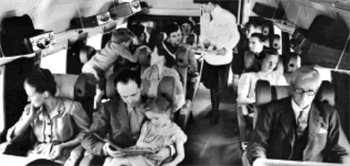 The DC-3 was built by the Douglas Aircraft Corporations beginning in the 1930s. It was an improvement on the DC-2 which seated only 12. (A famous DC-2 is the one featured during the song “On the Good Ship Lollipop”in the Shirley Temple movie, “Bright Eyes.”) The DC-3 had twin engines and could carry 14 passengers in a sleeper equipped cabin. (The sleeper cabin was modeled on the cabins of passenger trains, in which seats could be converted to beds during multiple-day trips.) Two seats were folded down to form the base for the lower bed, and the upper bunk folded down from the ceiling of the cabin. But the need to make airlines more profitable pushed developers to move from the sleepers to having planes that could carry more passengers and increasing the number of seats to 21 or even 24.
The DC-3 was built by the Douglas Aircraft Corporations beginning in the 1930s. It was an improvement on the DC-2 which seated only 12. (A famous DC-2 is the one featured during the song “On the Good Ship Lollipop”in the Shirley Temple movie, “Bright Eyes.”) The DC-3 had twin engines and could carry 14 passengers in a sleeper equipped cabin. (The sleeper cabin was modeled on the cabins of passenger trains, in which seats could be converted to beds during multiple-day trips.) Two seats were folded down to form the base for the lower bed, and the upper bunk folded down from the ceiling of the cabin. But the need to make airlines more profitable pushed developers to move from the sleepers to having planes that could carry more passengers and increasing the number of seats to 21 or even 24.
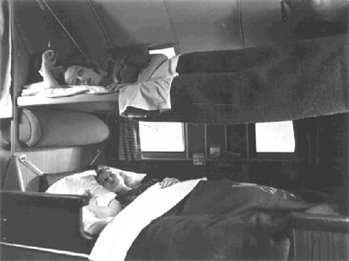 What was it like to ride on a DC-3? It was a lot rougher than riding on a modern passenger airplane. The passenger cabin of the DC-3 was not sealed from the outside air. This meant that the engine noise came into the cabin easily, making it a noisy place to be. The odors of the fuel, lubricants, and hydraulic fluids also came in, giving the airplane a peculiar “airplane smell.” The lack of a seal from the outside also meant that the airplane could not fly passengers above about 10,000 feet above the ground because above that altitude the air was too thin to breathe easily. But below that altitude, the airplane had to fly through or around clouds, storms, and other weather. The updrafts and downdrafts made the ride much bumpier than airplane rides are nowadays.
What was it like to ride on a DC-3? It was a lot rougher than riding on a modern passenger airplane. The passenger cabin of the DC-3 was not sealed from the outside air. This meant that the engine noise came into the cabin easily, making it a noisy place to be. The odors of the fuel, lubricants, and hydraulic fluids also came in, giving the airplane a peculiar “airplane smell.” The lack of a seal from the outside also meant that the airplane could not fly passengers above about 10,000 feet above the ground because above that altitude the air was too thin to breathe easily. But below that altitude, the airplane had to fly through or around clouds, storms, and other weather. The updrafts and downdrafts made the ride much bumpier than airplane rides are nowadays.
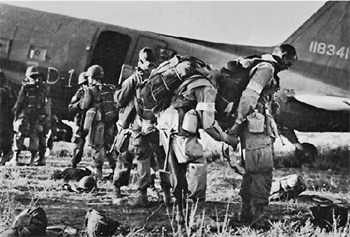 In earlier years the airlines had to rely on government mail delivery contracts to make a profit, but larger planes and more tickets sales finally made commercial flights able to pay for themselves. Just as the financial viability of air travel was finally proved, the second World War broke out and civilian aircraft were no longer manufactured due to wartime demands for military equipment. The DC-3 was renamed “C-47” by the United States Army (the United States Air Force had not been founded yet) and many more were built to ferry cargo around the world. They also carried paratroopers (soldiers who would jump out of airplanes and ride parachutes down to the ground, often behind enemy
In earlier years the airlines had to rely on government mail delivery contracts to make a profit, but larger planes and more tickets sales finally made commercial flights able to pay for themselves. Just as the financial viability of air travel was finally proved, the second World War broke out and civilian aircraft were no longer manufactured due to wartime demands for military equipment. The DC-3 was renamed “C-47” by the United States Army (the United States Air Force had not been founded yet) and many more were built to ferry cargo around the world. They also carried paratroopers (soldiers who would jump out of airplanes and ride parachutes down to the ground, often behind enemy
GRADES 3–5
NGSS: Engineering Design: Generate and compare multiple possible solutions to a problem based on how well each is likely to meet the criteria and constraints of the problem.The difference between the first piloted aircraft and the DC-3 is rather large. Just imagine the changes from the Wright Flyer with no cockpit for the pilot or space for a passenger, to having breakfast in bed served by a stewardess on board an overnight flight in a DC-3.

The Wright Flyer was built with a frame of spruce and ash, and covered in cotton cloth that had been treated with a type of paint used on boat sails. It had a four-cylinder engine that generated 12 horsepower and the craft flew at a maximum speed of 30 miles per hour. In contrast, the DC-3 had an enclosed metal fuselage and twin 9-cylinder engines producing 1,100 horsepower that gave it a cruising speed of 207 mph. The Wright Flyer carried the pilot and nothing else; it made four flights in all, the longest of which was 852 feet long. The DC-3 could also haul up to 6,000 pounds of cargo and cover 1,500 miles before needing to refuel. Later updates to the craft included more powerful engines and improved performance. The Wright Flyer made four flights on December 17, 1903 before a gust of wind picked it up and turned it over, damaging it badly; the DC-3 was so sturdy that some DC-3s are still being flown 75 years after they were made.
Here are some other points of comparison:
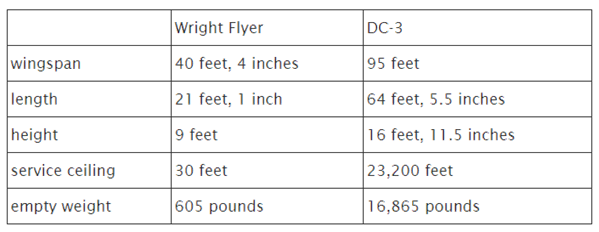
In an extraordinary coincidence, the first DC-3 flight took place exactly 32 years after the successful flight of the Wright Flyer. Considering all the changes that took place in those few short years, perhaps your students could research current comparisons for speed, wingspan, weight, and the like.
GRADES 6–8
NGSS: Engineering Design: Analyze data from tests to determine similarities and differences among several design solutions to identify the best characteristics of each that can be combined into a new solution to better meet the criteria for success.
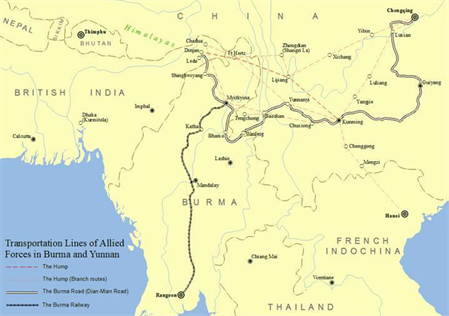 The DC-3 was designed as a passenger airplane in the 1930s. Between 1934 and 1943, when production of the passenger airplanes ceased, just over 600 airplanes had been built. With the coming of the Second World War, though, the United States Army needed transport planes and needed a lot of them. The Army selected the DC-3 for its basic design because of the airplane’s robustness, simplicity, reliability, and performance; they gave the airplane the military designation of “C-47”—“C” for “cargo.” Between 1941 and 1945, the Douglas Aircraft Company built more than ten thousand C-47s. (If you want your students to do the math, a manufacturing plant in Oklahoma City produced 5,354 C-47s between March 1943 and August 1945. Two and a half years times 365 days per year—this is not exact—gives a little more than 900 days. Dividing the number of airplanes by the number of days givens the result that the factory was turning out almost six airplanes per day—one every four hours or so. This is in addition to other airplanes that the factory was making. In fact, at peak production the factory produced thirteen C-47s per day.
The DC-3 was designed as a passenger airplane in the 1930s. Between 1934 and 1943, when production of the passenger airplanes ceased, just over 600 airplanes had been built. With the coming of the Second World War, though, the United States Army needed transport planes and needed a lot of them. The Army selected the DC-3 for its basic design because of the airplane’s robustness, simplicity, reliability, and performance; they gave the airplane the military designation of “C-47”—“C” for “cargo.” Between 1941 and 1945, the Douglas Aircraft Company built more than ten thousand C-47s. (If you want your students to do the math, a manufacturing plant in Oklahoma City produced 5,354 C-47s between March 1943 and August 1945. Two and a half years times 365 days per year—this is not exact—gives a little more than 900 days. Dividing the number of airplanes by the number of days givens the result that the factory was turning out almost six airplanes per day—one every four hours or so. This is in addition to other airplanes that the factory was making. In fact, at peak production the factory produced thirteen C-47s per day.
The C-47 saw service all over the world during the Second World War. One effort which is little known nowadays involved the resupply of the Chinese army in its fight against the Japanese. Japan attacked China in 1937, starting the Second Sino-Japanese War; by the time the United States declared war on Japan in December 1941, the Chinese had been cut off completely from sources of military supplies. The Americans started to fly supplies in an airlift over the Patkai and Santung mountain ranges—outliers of the Himalayas—from northeastern India to China. The route was called “the Hump.” Pilots flying cargoes over the Hump faced flying altitudes of 15,000 feet, extreme cold, terrible weather most of the year, and occasional Japanese fighters that came out to shoot down the unarmed cargo planes. But supplying the Chinese Army was worth it. Fighting the Chinese kept more than a million Japanese soldiers busy; had it not been for the airlift, those soldiers would have been sent elsewhere to fight.
There was an incident in Suifu, China in which a C-47 was caught on the ground during a Japanese raid and its right wing was destroyed by a bomb. There were no other C-47s at hand that could be cannibalized for a replacement wing, although there was a wing available from a DC-2. Even though the DC-2 wing was almost five feet shorter than the C-47 wing, the airplane flew successfully and was returned to service. It was affectionately called the “DC-2 ½.”
Another incident involving a C-47 in China happened when Japanese fighter aircraft strafed a C-47 while it was on the ground, putting several hundred bullet holes in it. Repair crews patched the holes and the crew started flying the airplane to safety. While they were on their way, they had to fly through a thunderstorm and the buffeting and the rain made the patches come off. The air rushing past each of the hundreds of holes made a loud whistling noise, but the airplane continued to fly. After they reached their destination, somebody asked the weary pilot why he had bothered to radio ahead, saying that “we could hear you coming for miles.”
One reason the DC-3 is so long-lived is that it was over-engineered. The engineers who designed the airplane figured out what its desired greatest load would be and then made the airplane strong enough to carry twice that load—and then some. It was also designed to be simple and economical: earlier airplanes were so expensive to operate that they could not carry passengers profitably. (The price of the passengers’ tickets was less than the operating costs of the airplane and the airlines relied on government air mail contracts to make up the difference.) This simplicity worked strongly in the DC-3’s favor when it came to keeping the airplane in service. Indeed, some DC-3s are still flying.
GRADES 9–12
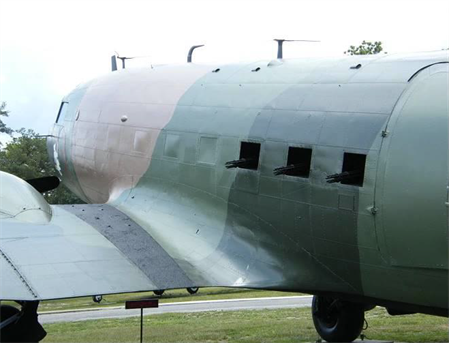 During the Vietnam War, about fifty C-47 aircraft from the Second World War were fitted out with three 7.62 mm Gatling guns and used to support troops on the ground. (A Gatling gun is a machine gun with multiple barrels. The “7.62 mm” measures the inside diameter of each barrel; can your students convert that into calibers? One caliber is one hundredth of an inch.) Because they were now being used for ground attack, the “C-47” designation was preceded by an “A,” making the aircraft the “AC-47.” Here is a video describing the AC-47.
During the Vietnam War, about fifty C-47 aircraft from the Second World War were fitted out with three 7.62 mm Gatling guns and used to support troops on the ground. (A Gatling gun is a machine gun with multiple barrels. The “7.62 mm” measures the inside diameter of each barrel; can your students convert that into calibers? One caliber is one hundredth of an inch.) Because they were now being used for ground attack, the “C-47” designation was preceded by an “A,” making the aircraft the “AC-47.” Here is a video describing the AC-47.
The Gatling guns were put on the left-hand side of the airplane, over the wing, and fired directly to the left. This allowed the pilot of the airplane to circle around the target on the ground in what was called a “pylon turn,” firing continuously. It was more effective than the traditional ground support mode of making a pass over the target, circling around, and coming back for another pass. The guns could not move independently of the airplane, meaning that to aim the guns the pilot had to maneuver the airplane. In practice, this was not very difficult for an experienced pilot to do.
The AC-47 aircraft flew mostly at night, in part to protect them from enemy fire but mostly because night-time was when their services were needed most. They carried anywhere from two dozen to five dozen flares, depending on what the mission required, and a standard load of 21,000 rounds of ammunition. An airplane would fly over the target area and drop one or more flares; the flares, suspended by parachutes, would burn brightly for three minutes and illuminate the target area on the ground. The airplane would then go into its “pylon turn,” usually firing 1,000 bullets per minute per gun. Every fifth bullet was a tracer which lit up as it left the gun barrel and showed where the stream of bullets was going, allowing the pilot to adjust the aim point as needed. The effect on the ground was devastating to the enemy; in five thousand times the AC-47s showed up to protect ground troops from enemy attack, the enemy never succeeded in overrunning the defended position.
The AC-47 aircraft went by the call signs “Puff the Magic Dragon” and “Spooky.” (A call sign is an informal name used in the military. Among other uses, when speaking on the radio it allows our troops to identify each other without the enemy listening in figuring out who is who.) The name “Puff the Magic Dragon” came from a children’s song that was popular at the time, with obvious references to the “fire-breathing” of the AC-47’s guns. A former AC-47 pilot told your writer that the name “Spooky” came from an Army officer on the ground who, when told that some AC-47s were on their way to help him fight off an attack, replied, “Those spooky guys?” (Other sources may give other origins for the name.)
If the gentle reader will permit a personal note, your writer’s father was a corporal in the Army at Lackland Army Base in San Antonio, Texas after the Second World War ended. There were many war surplus C-47s stationed at Lackland and the Army had a policy that any lieutenant or captain on the base could borrow a C-47 for the weekend and fly it to anywhere within 1,000 statute miles. When the officers learned that your writer’s father could read a map, they taught him how to fly the airplane at its cruising altitude. A group of officers would borrow an airplane and one of them would take off and bring the airplane up to cruising altitude. He would then turn the control of the airplane over to your writer’s father and the officers would go to the back part of the airplane to play cards. Every fifteen or twenty minutes, an officer would come forward and ask where they were; your writer’s father would indicate the airplane’s position on the map, point to a couple of landmarks on the map, and point to the landmarks out the window. “Very good, carry on,” the officer would say, and would go back for another round of cards. Your writer’s father was about eighteen years old at the time; at an age when most young men are beginning to drive cars he was flying airplanes. While probably not open to teen-agers, there are still organizations that will teach people to fly DC-3s.
Your writer also heard a story from an old retired Air Force officer of a long C-47 flight during which the pilot turned the controls over to the copilot and went back to the back part of the airplane to take a nap. As the airplane approached its destination, another member of the crew got onto the intercom and asked the copilot whether he should wake the pilot up to land the airplane. “No,” replied the copilot, “I will land the plane.” The copilot landed the airplane very smoothly with hardly a bump and taxied over to the place it was to park. Then he got on the intercom again and announced to the crew: “OK, here’s the plan. When I cut the engines, everybody grab his parachute and run for the back door.” (I am sure you can imagine the effect this had on the pilot.) The man who told me the story did not tell me whether he was the pilot, the copilot, or another member of the crew.
Sixty Years Ago in the Space Race:
March 20, 1959: The Massachusetts Institute of Technology announced that it had successfully bounced radar signals off the planet Venus, measuring the size of the Solar System with unprecedented accuracy.
